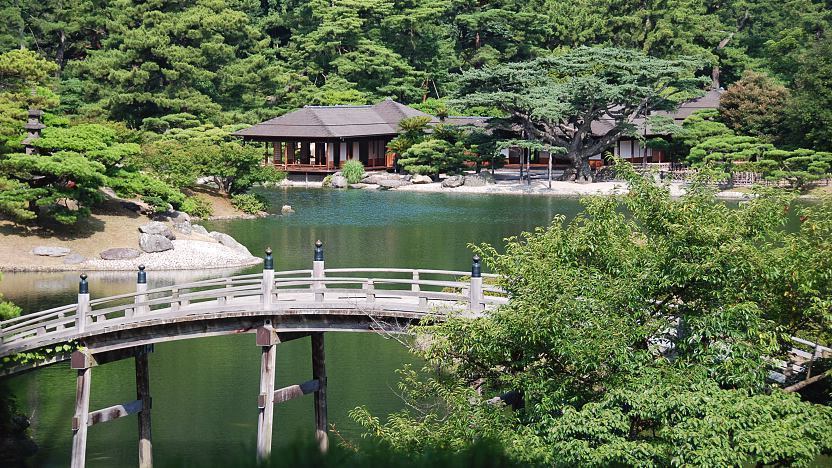Garden Elements

Japanese gardens utilize elements such as ponds, streams, islands and hills to create miniature reproductions of natural scenery. The following are commonly employed elements:
Stones, gravel and sand
Since ancient times, stones have played an important role in Japanese culture. In Shinto, prominent large stones are worshiped, while gravel has been used to designate sacred grounds, as seen at some ancient shrines such as the Ise Shrines or Kyoto's Kamigamo Shrine.
In today's gardens, large stones symbolize mountains and hills, set decorative accents and serve as the building material for bridges and pathways. Smaller rocks and gravel are used to line ponds and streams. Meanwhile, dry gardens are comprised entirely of stones, with larger stones symbolizing mountains, islands and waterfalls, while gravel and sand replace water.




Ponds, streams and waterfalls
Ponds are a central element of most gardens and often represent real or mythical lakes or seas. Sometimes they provide a habitat for carps (koi) which introduce additional color and life to the garden. In dry gardens, ponds, streams and waterfalls are symbolized by raked gravel, sand and upright stones.
In recreational types of gardens, ponds can be used for boating or enjoyment from pavilions built out over the water or from plazas and embankments on shore, which often served as the site for aristocratic poetry or moon viewing parties in past centuries.





Islands and bridges
Islands are another long standing component of Japanese gardens, and range in size from single stone outcroppings to large islands big enough to support buildings. They often represent real islands or have religious symbolism, such as those built to resemble turtles and cranes, symbols of longevity and health, or Horai, a sacred mystical mountain in Taoism.
Bridges are another common feature that is used to connect islands and cross streams or ponds. They are built of stone or wood, and range in complexity from a simple slab of uncut rock laid across a stream to elaborate, covered wooden structures over ten meters long.





Vegetation
Trees, shrubs, lawns and flowers of all kinds are used in Japanese gardens. Plants, such as maple and cherry trees, are often chosen for their seasonal appeal and are expertly placed to emphasize these characteristics. Conversely, pine trees, bamboo and plum trees are held in particular esteem for their beauty during the winter months when other plants go dormant. Mosses are also used extensively, with over a hundred species appearing at Kokedera alone.
Plants are carefully arranged around the gardens to imitate nature, and great efforts are taken to maintain their beauty. Trees, shrubs and lawns are meticulously manicured, and delicate mosses are swept clean of debris. During winter, straw, burlap and ropes are used to insulate and protect the trees and shrubs from the freezing snow, while straw wraps protect against bug infestations.




Hills
Larger gardens, especially the strolling gardens of the Edo Period, make use of large man-made hills. The hills may represent real or mythical mountains, and some can be ascended and have a viewpoint from where visitors are treated to a panoramic view out over the garden.


Lanterns
Lanterns come in a variety of shapes and sizes and have been a common element of Japanese garden design throughout history. They are usually made of stone and placed in carefully selected locations, such as on islands, at the ends of peninsulas or next to significant buildings, where they provide both light and a pleasing aesthetic. Lanterns are often paired with water basins (see more details below), which together make up a basic component of tea gardens.



Water basins
Many gardens contain stone water basins (tsukubai) for ritual cleansing, especially ahead of tea ceremonies. The basins vary from simple depressions in uncut stone to elaborate, carved stone creations, and are usually provided with a bamboo dipper for scooping up water. These days they often appear as a decorative addition more than for a practical purpose. Water basins are an essential element of tea gardens and are often paired with lanterns.



Paths
Paths became an integral part of Japanese gardens with the introduction of strolling and tea gardens. Strolling gardens feature circular paths constructed of stepping stones, crushed gravel, sand or packed earth, which are carefully prescribed to lead visitors to the best - albeit controlled - views of the garden. Winding paths also serve to segregate different areas, such as an isolated grove or hidden pond, so that they may be contemplated individually.



Buildings
Many types of gardens were built to be viewed from inside buildings, such as palaces, villas or temples. In contrast, gardens meant to be entered and enjoyed from within, use buildings as a part of the garden's composition, including pavilions, tea houses and guest houses.




Borrowed scenery
Borrowed scenery (shakkei) is the concept of integrating the landscape outside of the garden into the design of the garden. Both, natural objects such as mountains and hills and man-made structures such as castles, can be used as borrowed scenery. In modern times, skyscrapers have become a (usually) unintentional borrowed scenery for some gardens in the cities.



Questions? Ask in our forum.


